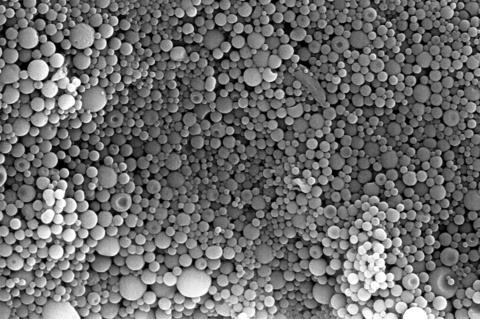UI and ISU researchers team up to develop nanoparticle-based universal flu vaccine
Last year, flu killed an estimated 80,000 Americans—the most in more than 40 years—and hospitalized 900,000, according to the Centers for Disease Control and Prevention (CDC).
The annual flu shot is the most effective strategy for preventing flu, or at least minimizing the harm caused by this serious illness. However, every flu season brings a new set of circulating flu strains, which means the seasonal vaccine is only good for one year.
In addition, the match between the flu strains targeted by the vaccine (based on a prediction of the strains most likely to be prevalent during the coming flu season) and those that actually show up, varies from year to year, altering the effectiveness of the shot.
A universal flu vaccine—one that provides strong, long-lasting protection against multiple strains of flu—could do away with the need to create and administer the annual shot. Instead, a single vaccine could protect people from many strains of flu for multiple years. It might even protect against new, emerging flu strains that have the potential to cause a pandemic.

These nanoparticles average just 300 billionths of a meter across and contain vaccine antigens. Image courtesy of the Iowa State University Nanovaccine Institute.
Inhaled vaccine showed promise in mice
Researchers at the University of Iowa, in collaboration with colleagues at Iowa State University, are working on a universal flu vaccine based on nanoparticle technology. In a recently published study, the team of Kevin Legge, PhD, and Thomas Waldschmidt, PhD, both in the Department of Pathology at the University of Iowa, and Balaji Narasimhan, director of the Nanovaccine Institute at Iowa State University, showed that their nanoparticle vaccine delivered by inhalation was able to protect mice from multiple strains of flu.

“There is currently considerable interest in universal influenza virus vaccination. The NIH has recently released a strategic plan to achieve this goal,” Legge says. “Our vaccine’s ability to protect mice against both the strain of virus used in the vaccine as well as a very different and dangerous strain means that it may be able to achieve this goal.”
Legge adds that the vaccine’s nanoparticle chemistry developed by his colleagues at Iowa State University means it can be administered without the need for needles. It also allows the vaccine to break the “cold chain”—the series of cold shipping, cold storage, and cold distribution required to prevent loss of effectiveness.
“For many places in the world, maintaining the cold-chain is not easy or is very costly,” Legge explains. “Our collaborators have previously shown that proteins placed in the nanoparticles are stable even when stored above room temperature. Thus, the nanoparticles remove the need for the cold-chain.”
Right type, right place immunity
Legge and his team used their understanding of which types of immune cells and molecules provide protection after natural influenza infection to design a vaccine that produces a similar immune response without the adverse side effects of actually getting infected.
A natural flu infection prompts the production of both antibodies and T-cells. Antibodies offer protection by coating the outside of the virus and preventing the flu virus from binding to cells in the airway and initiating an infection. T-cells, on the other hand, are the immune system’s hunter-killer cells, and eliminate influenza that has established a foothold in the lung by killing the cells infected with the virus. Current vaccines largely work by driving an antibody response only and generally do not induce T-cell production. Additionally, natural infection drives a local immune response within the lower lungs, setting up immunity at the site of future influenza virus exposures.
The team found that mice given inhaled, biocompatible nanovaccine particles containing influenza A virus proteins were protected against both the influenza strain in the vaccine and against a different, dangerous strain of influenza A.
The study showed that this protection was associated with the production of T-cells in the lungs as well as antibody production both in the lungs and throughout the body.
“We were able to show that our nanoparticle-based approach is able to induce both antibodies and T-cells, and those responses are poised in the lower airways to allow a robust protection,” Legge says.
The researchers showed that their vaccine also worked in “outbred” mice—mice that are genetically diverse compared to the original inbred group of mice used for the tests.
This is important because unlike traditional lab mice, humans are genetically very diverse, and that diversity influences how individual immune systems respond to vaccines.
Overall, the findings suggest that the nanovaccine platform may hold promise for creating a universal flu shot.
“Our future studies will test the ability of the nanoparticle vaccine to provide ‘universal’ protection against a broad panel of seasonal and potential pandemic influenza viruses as well as perform pre-clinical trials to ensure safety,” Legge says.